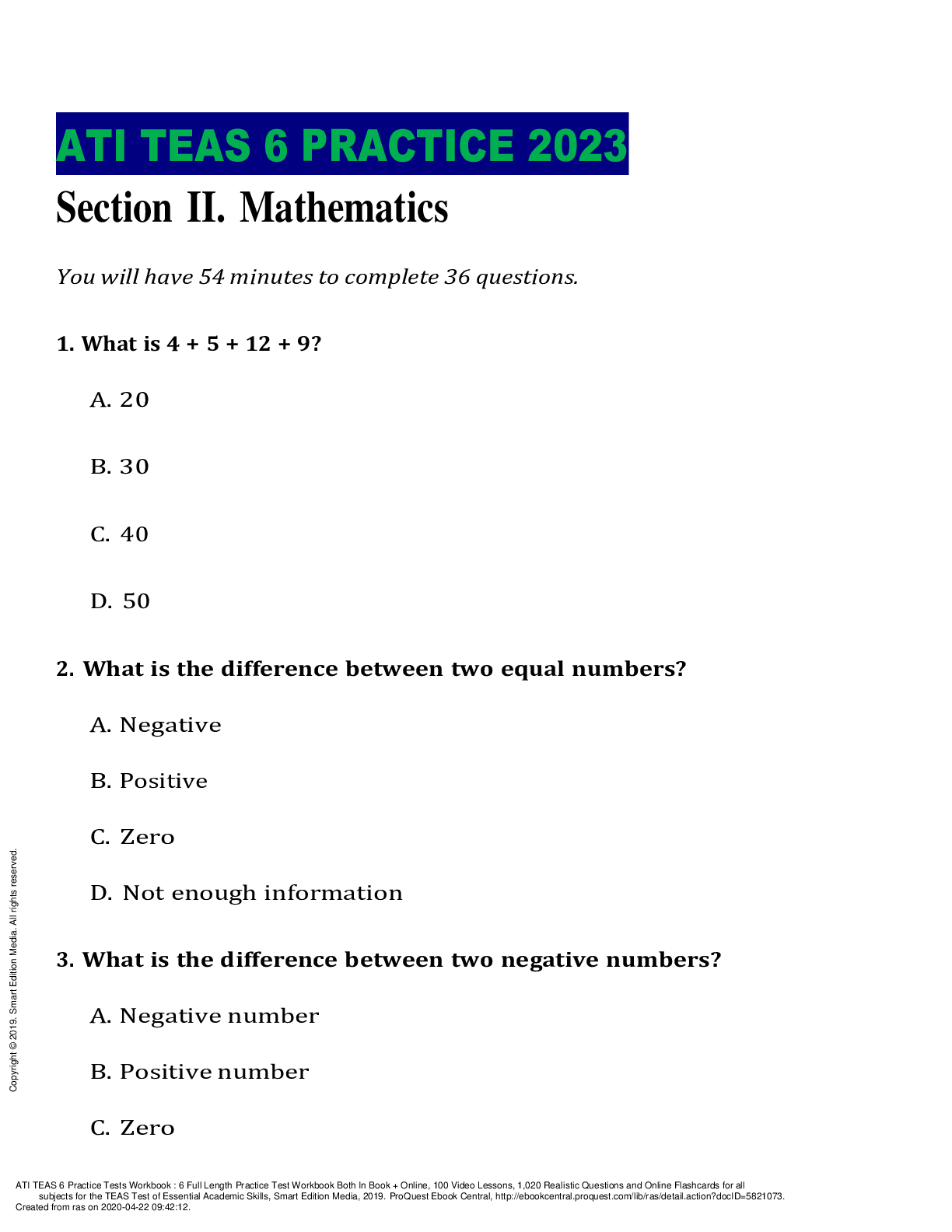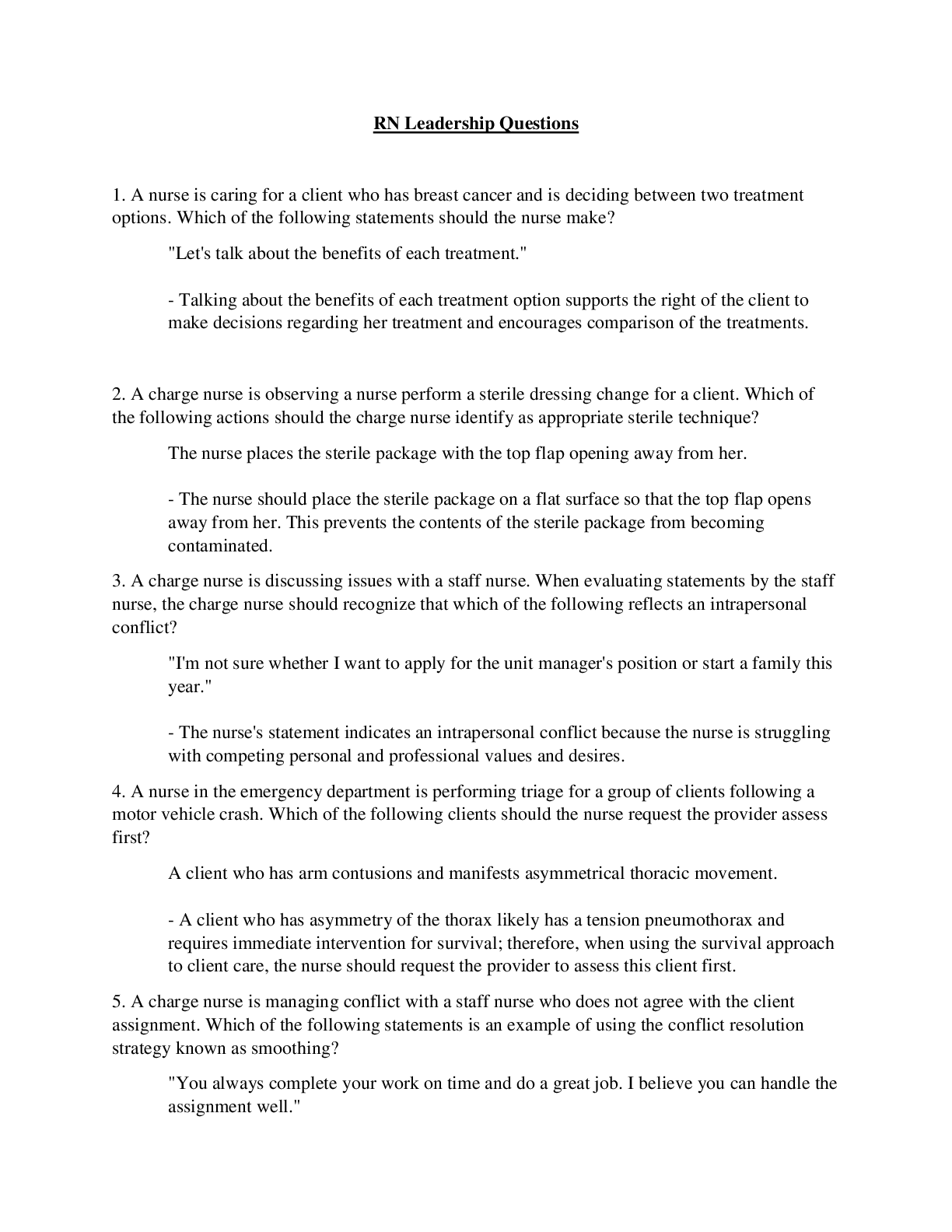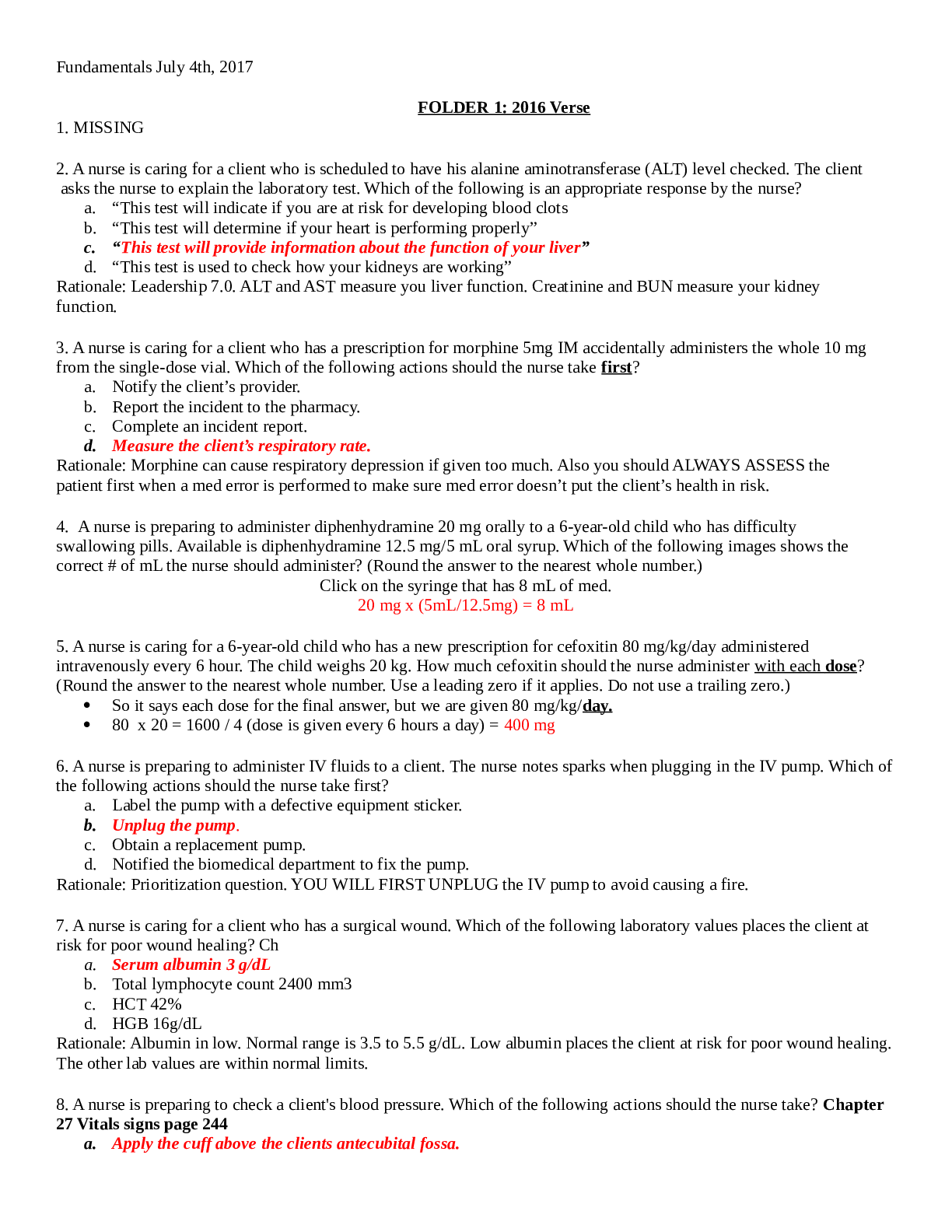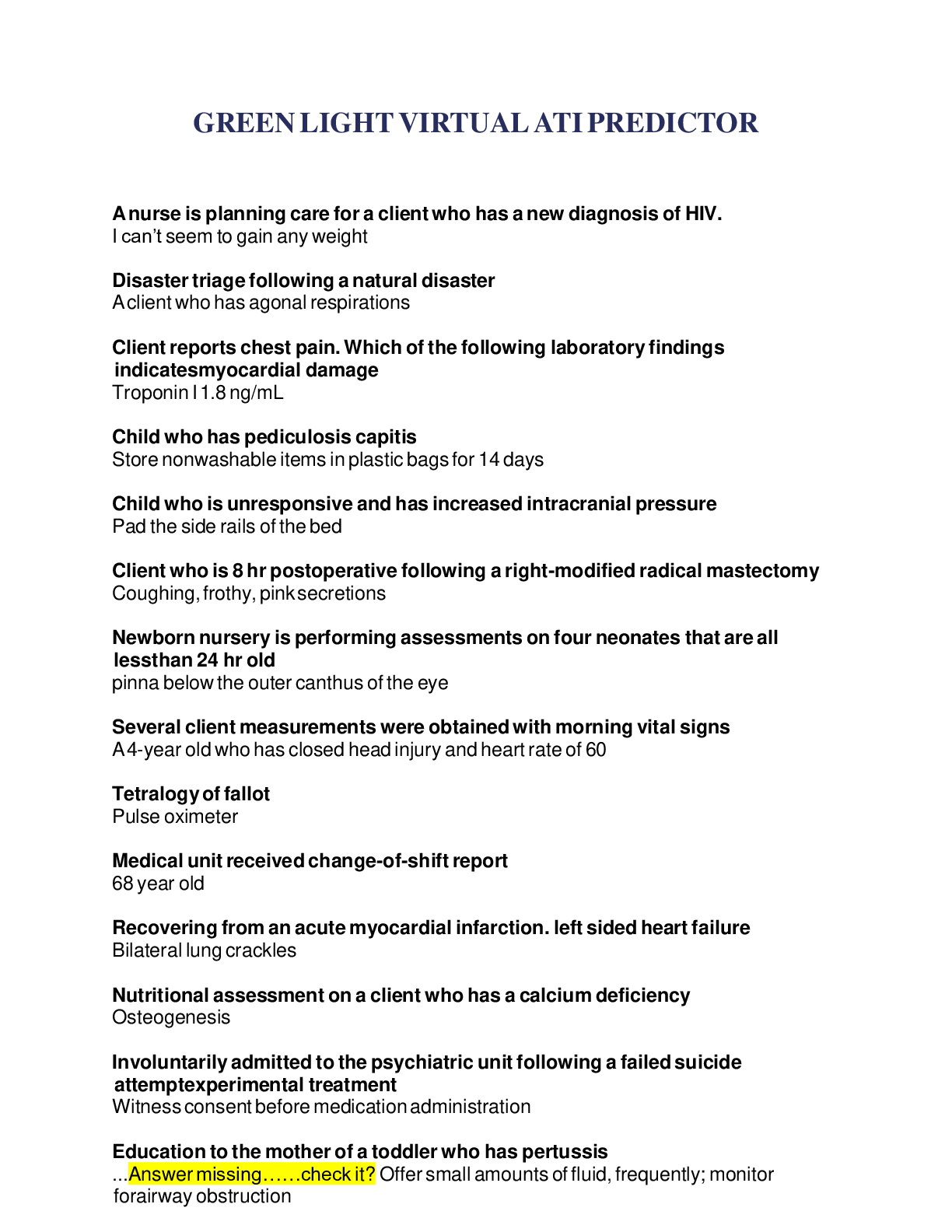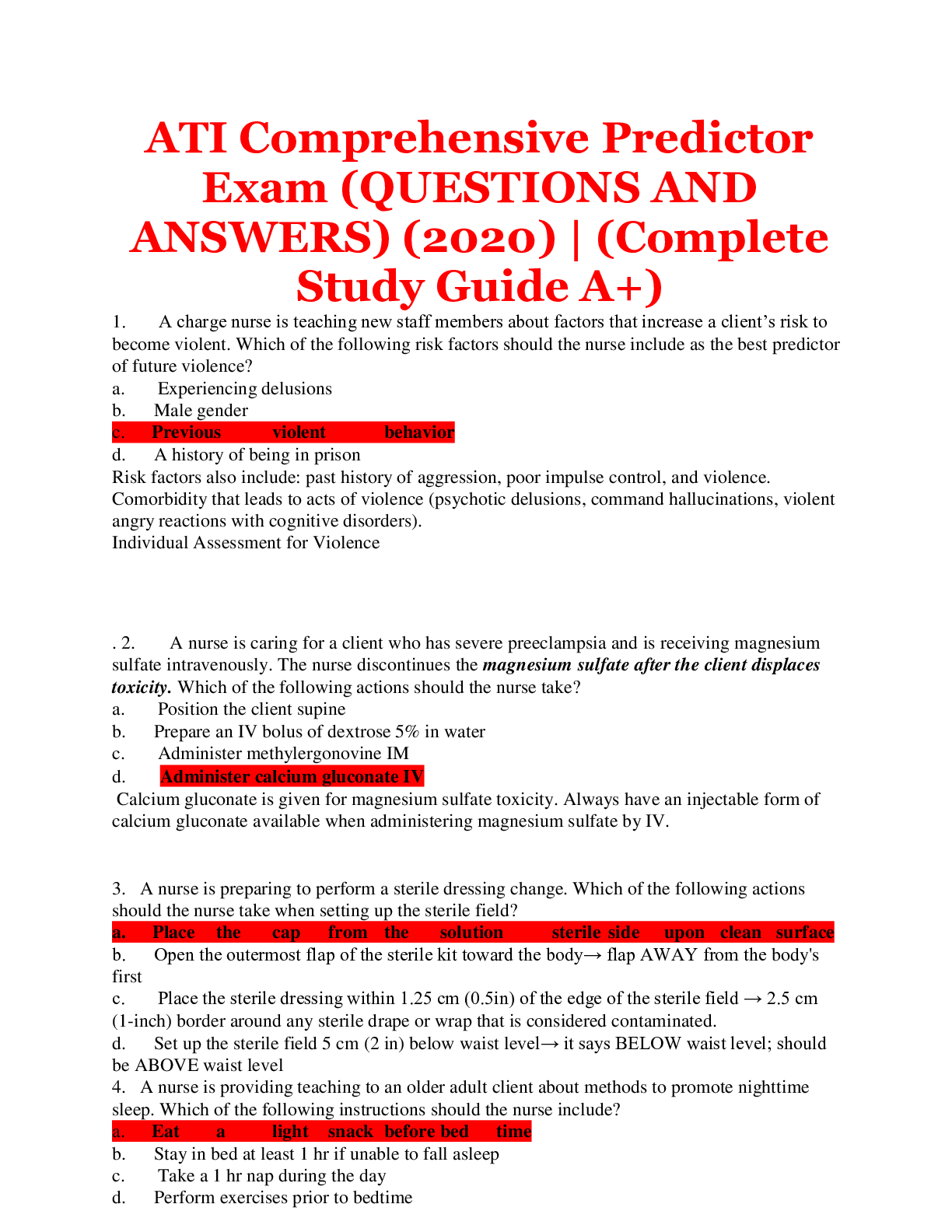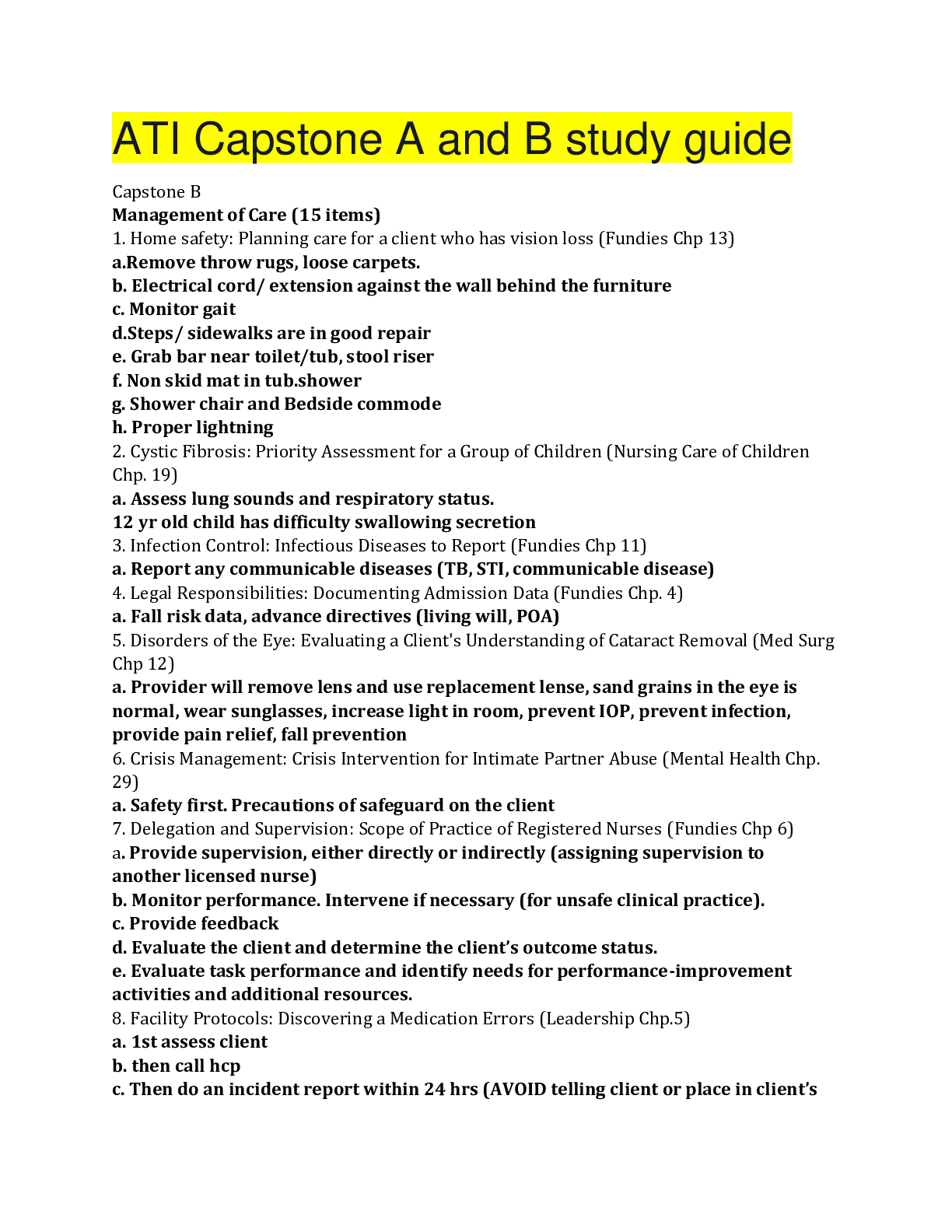*NURSING > QUESTIONS and ANSWERS > WCJC ADN SN ATI Learning ;ATI Level 3 Practice A Remediation / NURS 2363ATI Level 3 Practice A Remed (All)
WCJC ADN SN ATI Learning ;ATI Level 3 Practice A Remediation / NURS 2363ATI Level 3 Practice A Remediation
Document Content and Description Below
WCJC ADN SN ATI Learning ATI Concept-Based Level 3 Practice A Remediation Cognition Alzheimer's Disease Neurocognitive Disorders: Identifying the Earliest Possible Indicator of Alz... heimer's Disease • Stage 1: Mild • Memory lapses • Losing or misplacing items • Difficulty concentrating and organizing • Unable to remember material just read • Still able to perform ADLs • Short term memory loss noticeable to close relations • Stage 2: Moderate • Forgetting events of one's own history • Difficulty performing tasks that require planning and organizing (paying bills, managing money) • Difficulty with complex mental arithmetic • Personality and behavioral changes: appearing withdrawn or subdued, especially in social or mentally challenging situations; compulsive; repetitive actions • Changes in sleep patterns • Can wander and get lost • Can be incontinent • Clinical findings that are noticeable to others • Stage 3: Severe • Losing ability to converse with others • Assistance required for ADLs • Incontinence • Losing awareness of one's environment • Progressing difficulty with physical abilities (walking, sitting, and eventually swallowing) • Death frequently related to choking or infection Schizophrenia Psychotic Disorders: Identifying Cognitive Symptoms of Schizophrenia • Cognitive Symptoms: Problems with thinking making it very difficult for the client to live independently • Disordered thinking • Inability to make decisions • Poor problem-solving ability • Difficulty concentrating to perform tasks • Memory deficits • Long term memory • Working memory, such as inability to follow directions to find an address End of Life Organ and Tissue Donation Grief, Loss, and Palliative Care: Evaluating Teaching About Organ and Tissue Donation • Provide support and education to family members as decisions are being made. News private areas for any family discussions concerning donation. • Be sensitive to cultural and religious influences. • In order to keep the organs viable, ventilatory and cardiovascular support must be maintained • Answer any of the questions the family has • Provide care with respect and compassion while attending to the desires of the client and family per their cultural, religious, and social practices. Check the client’s religion and make attempts to comply • The provider typically approaches the family about performing an autopsy • The law can require an autopsy to be performed if the death is due to homicide, suicide, or accidental death, or if death occurs within 24 hr of hospital admission Human Growth and Development Cerebral Palsy Chronic Neuromusculoskeletal Disorders: Planning Care for a Toddler Who Has Cerebral Palsy • Individualized care to meet client needs • monitor developmental milestones • evaluate the need for hearing and speech evaluations • assess the family’s awareness of available resources • communicate with the child directly, but include the parents as needed • encourage family to help verify the client's needs if communication is impaired • maintain an open airway by elevating the head of the child's bed (especially important if the child has increased oral secretions) • ensure suction equipment is available if required • monitor for pain using a developmentally appropriate pain tool • ensure adequate nutrition • Assess for the possibility of aspiration for children who are severely disabled • Determine the child’s ability to take oral nutrition • Provide foods that are similar to food eaten at home when possible • Maintain weight/height chart • Administer medication for pain and/or spasms as required • Provide skin care • Assess skin under splints and braces if applicable • Maintain skin integrity by turning child to keep pressure off bony prominences • Provide rest periods as needed • Educate the family about plan of care, medications, therapies, treatments • Coordinate care with other professionals such as speech, physical and recreational therapists, and education and/or medical specialists. Newborn Complications Chronic Neuromusculoskeletal Disorders: Planning Care for a Newborn Who Has a Myelomeningocele • Spina bifida cystica: protrusion of the sac is visible • Myelomeningocele: The sac contains spinal fluid, meninges, and nerves • Nursing Care: • Assess for infant-parent attachment • Assess the sac • Perform routine newborn assessment • Assess the level of neurologic involvement • Obtain accurate output measurements • Assess head circumference and fontanels • Preoperative • Prepare the family for surgery • Protect the sac from injury • Place infant in a woman, without clothing • Apply a sterile, moist, non-adhering dressing with 0.9% sodium chloride on the sac, changing it every two hours • Assess for systemic indications of infection (fever, irritability, and lethargy) • Administer IV antibiotics • Postoperative • Monitor vital signs, I&O • Assess for indications of infection • Provide pain management • Provide incision care • Assess the CSF leakage • Maintain prone position until other positions are prescribed • Resume oral feedings • Provide range of motion to extremities • Education • Provide teaching for postoperative care at home • Depending on disability, teach ROM techniques Immunity Rheumatoid Arthritis Connective Tissue Disorders: Client Teaching About Methotrexate • Purpose of Methotrexate • Slows joint degeneration and progression of rheumatoid arthritis • Slow/delay the worsening of the disease • Administration • Advise clients that effects of DMARDs are delayed and can take 3 to 6 weeks, with full therapeutic effect taking several months • Complications: • Increased risk of infection Advise clients to notify the provider immediately for manifestations of infection (fever, sore throat) • Hepatic fibrosis and toxicity monitor liver function tests. Advise the clients to observe for anorexia, abdominal fullness, and jaundice, and to notify the provider if symptoms occur • Bone marrow suppression obtain baseline CBC, including platelet counts. Repeat every three to six months • Ulcerative stomatitis/other GI ulcerations (early finding with toxicity) Inspect mouth, gums, and throat daily for ulcerations, bleeding, or color changes Advise clients to take the medication with food or 8 oz of water Stop the medication if symptoms occur • Fetal death/congenital abnormalities avoid use during pregnancy, advise clients to use adequate contraception if taking this medication • Contraindications • This medication is pregnancy risk category X • methotrexate is contraindicated in clients who have liver failure, alcohol use disorder, or blood disgrasias • Use with caution in clients who have liver or kidney dysfunction, cancer and suppressed bone marrow function, peptic ulcer disease , ulcerative colitis , impaired nutritional status, or infections • use cautiously with children, or woman who are breast feeding Intracranial Regulation/Neural Regulation Epilepsy Seizures and Epilepsy: Identifying the Preictal Phase • Triggering Factors: • Increase physical activity • Excessive stress • Hyperventilation • Overwhelming fatigue • Acute alcohol ingestion • Excessive caffeine intake • Exposure to flashing lights • Substances such as cocaine, aerosols, and inhaled glue products • Generalized seizures can begin with an aura (alteration in vision, smell, hearing, or emotional feeling Mood and Affect Personality Disorders Personality Disorders: Assessing for Characteristics of Schizoid Personality Disorder • Schizoid Personality Disorder: • Characterized by emotional detachment, disinterest in close relationships, and indifference to praise or criticism; often uncooperative Perfusion >>CONTINUED>>> [Show More]
Last updated: 1 year ago
Preview 1 out of 11 pages
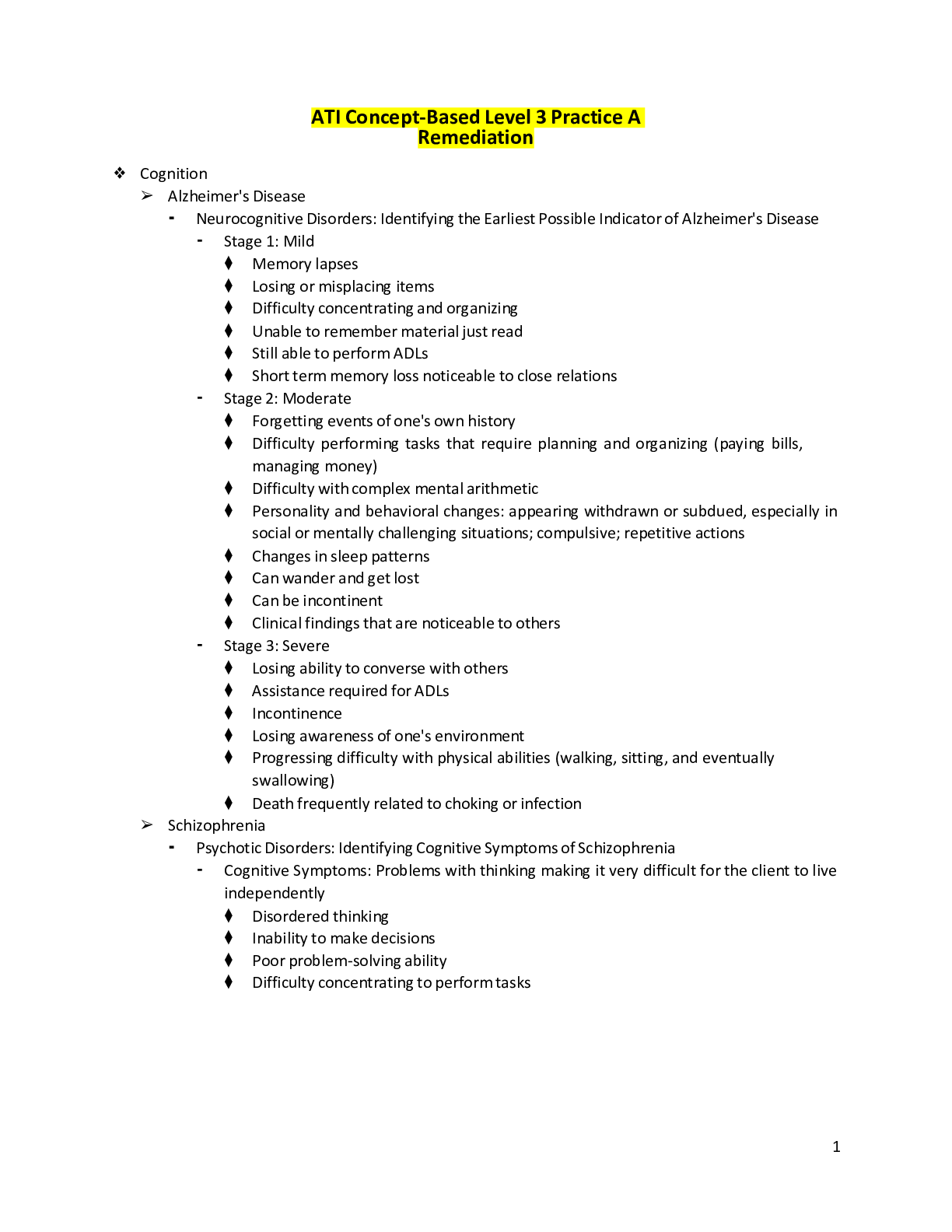
Reviews( 0 )
Document information
Connected school, study & course
About the document
Uploaded On
Feb 12, 2021
Number of pages
11
Written in
Additional information
This document has been written for:
Uploaded
Feb 12, 2021
Downloads
0
Views
46



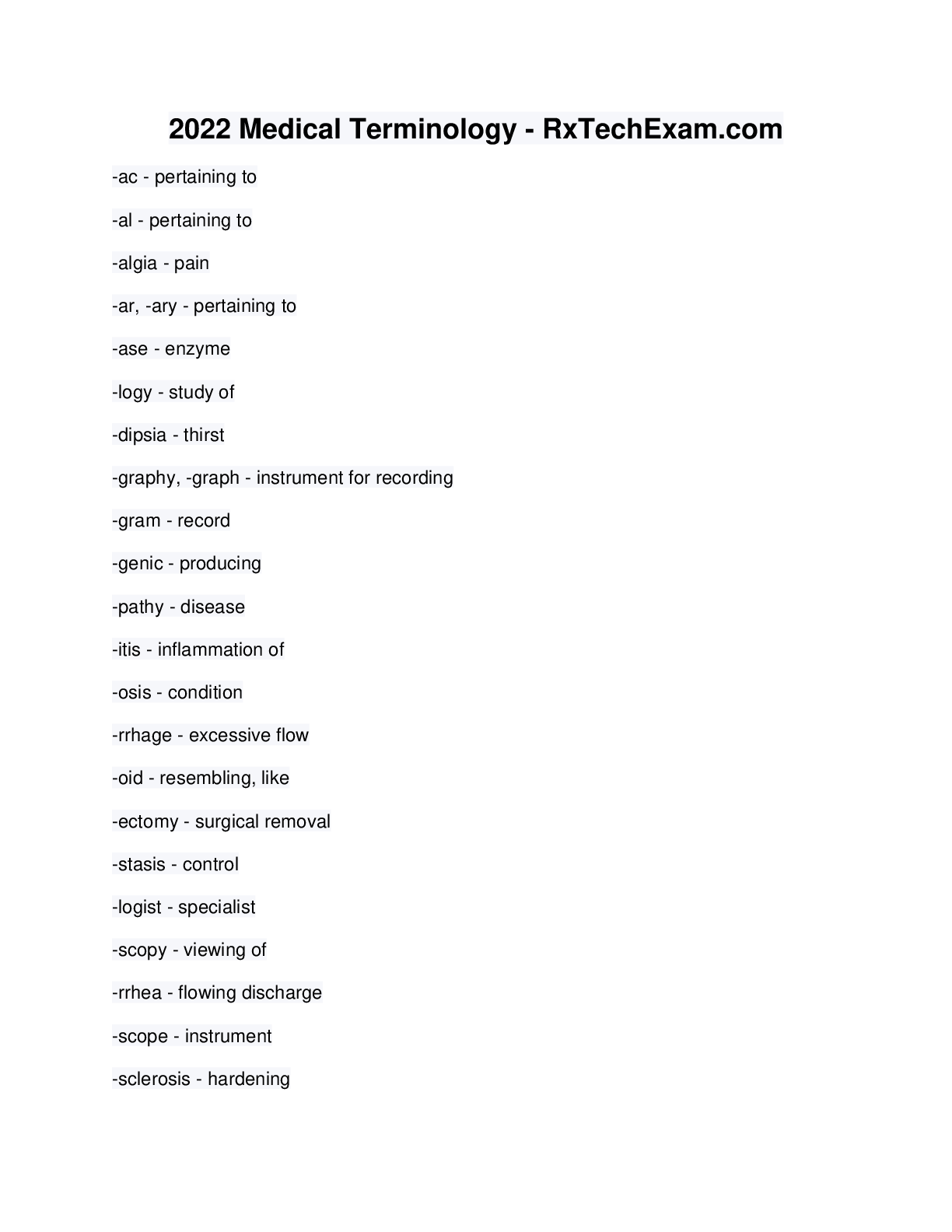

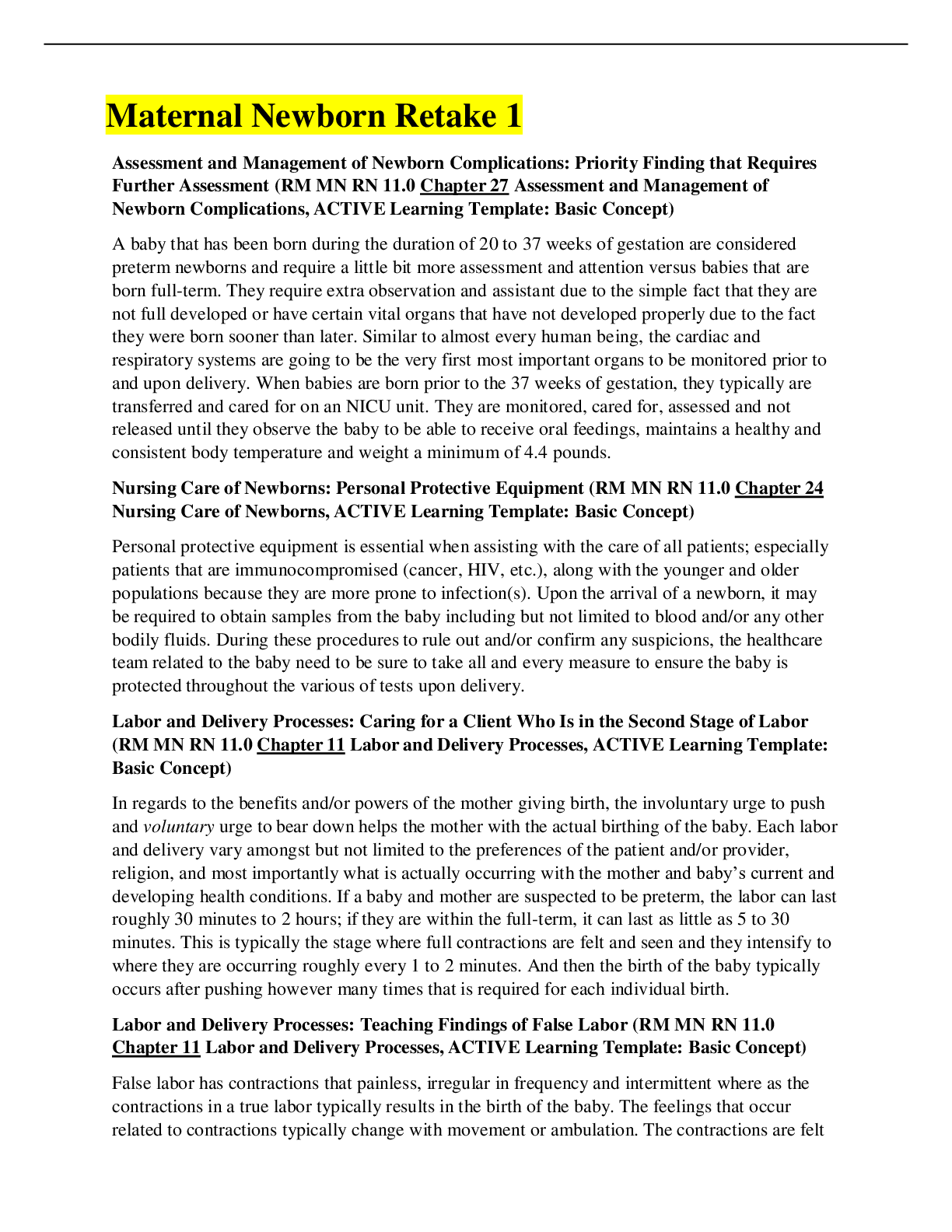

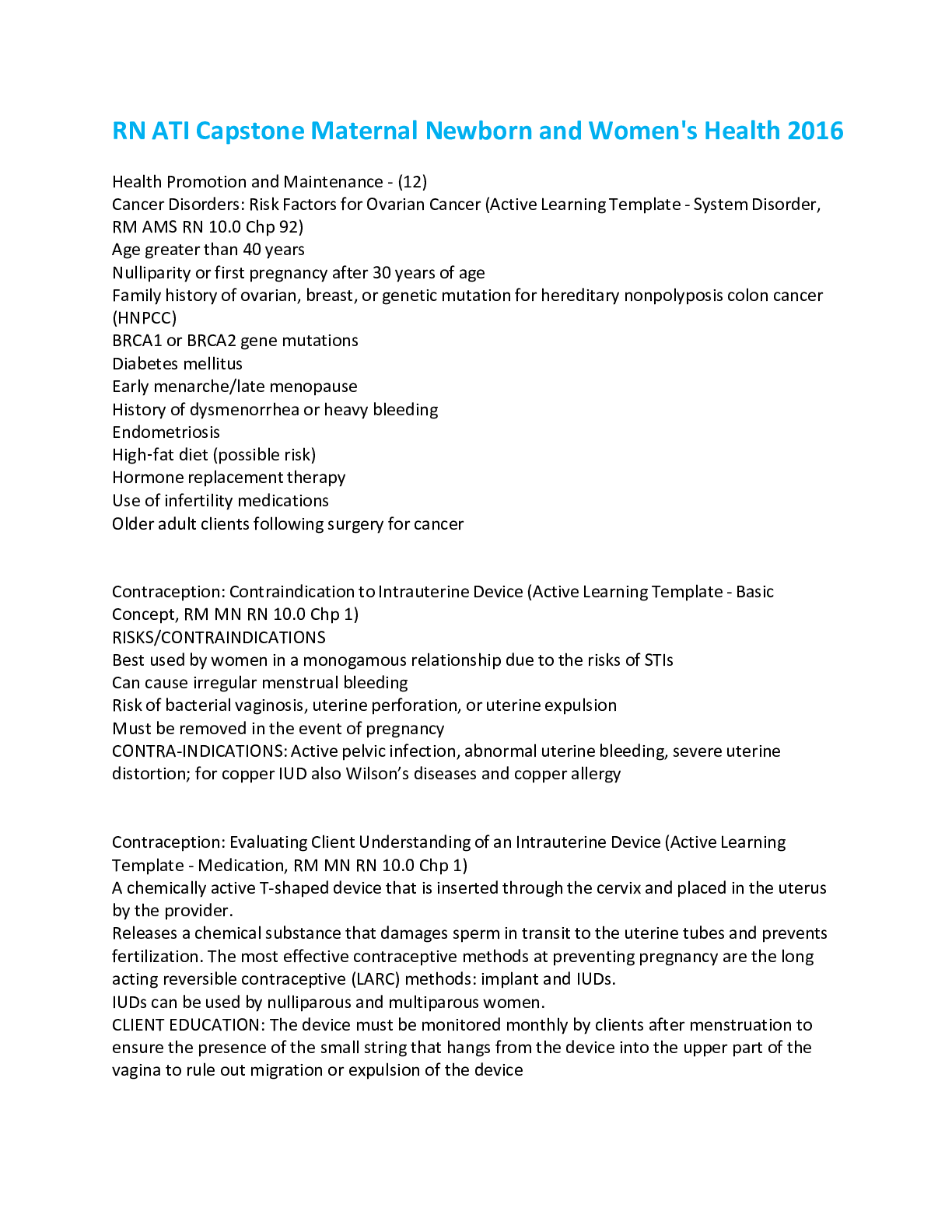
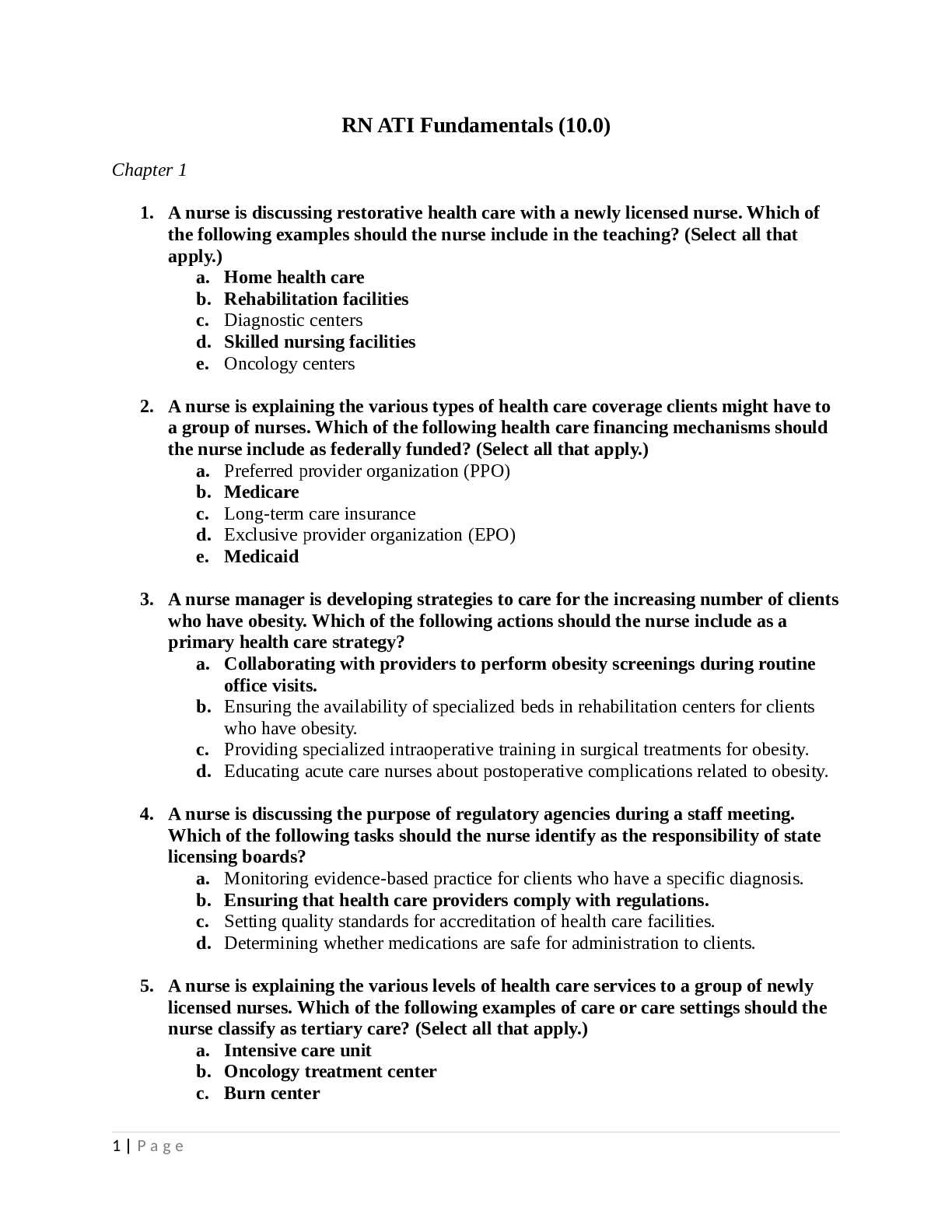

.png)
.png)
